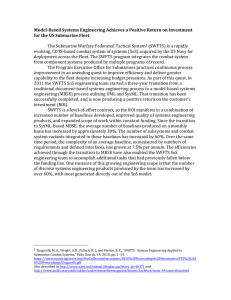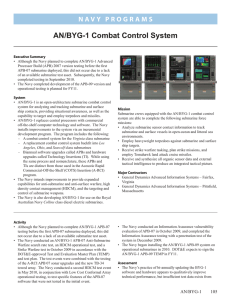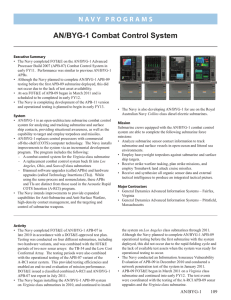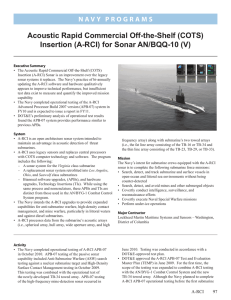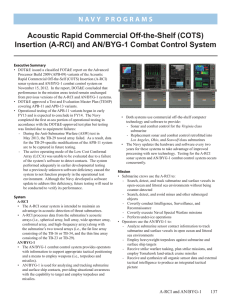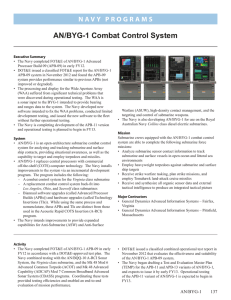AN/BYG-1 Combat Control System
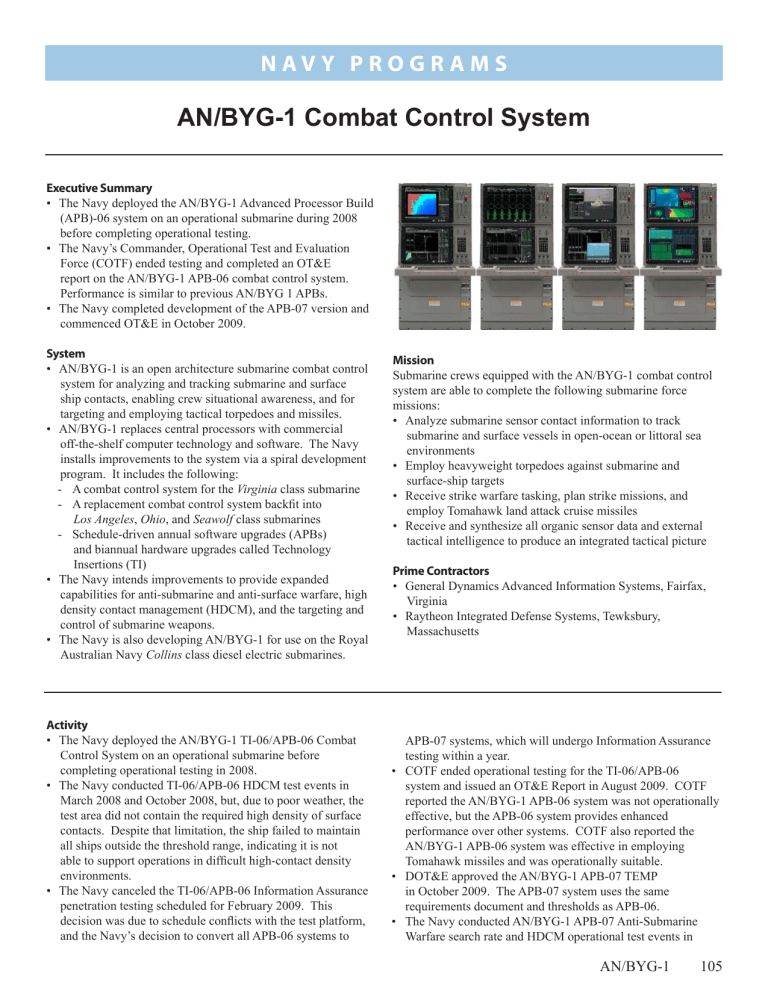
n a v y P r o g r a M s
AN/BYG-1 Combat Control System
executive summary
• The Navy deployed the AN/BYG-1 Advanced Processor Build
(APB)-06 system on an operational submarine during 2008 before completing operational testing.
• The Navy’s Commander, Operational Test and Evaluation
Force (COTF) ended testing and completed an OT&E report on the AN/BYG-1 APB-06 combat control system.
Performance is similar to previous AN/BYG 1 APBs.
• The Navy completed development of the APB-07 version and commenced OT&E in October 2009. system
• AN/BYG-1 is an open architecture submarine combat control system for analyzing and tracking submarine and surface ship contacts, enabling crew situational awareness, and for targeting and employing tactical torpedoes and missiles.
• AN/BYG-1 replaces central processors with commercial off-the-shelf computer technology and software. The Navy installs improvements to the system via a spiral development program. It includes the following:
- A combat control system for the Virginia class submarine
- A replacement combat control system backfit into
Los Angeles , Ohio , and Seawolf class submarines
- Schedule-driven annual software upgrades (APBs) and biannual hardware upgrades called Technology
Insertions (TI)
• The Navy intends improvements to provide expanded capabilities for anti-submarine and anti-surface warfare, high density contact management (HDCM), and the targeting and control of submarine weapons.
• The Navy is also developing AN/BYG-1 for use on the Royal
Australian Navy Collins class diesel electric submarines.
Mission
Submarine crews equipped with the AN/BYG-1 combat control system are able to complete the following submarine force missions:
• Analyze submarine sensor contact information to track submarine and surface vessels in open-ocean or littoral sea environments
• Employ heavyweight torpedoes against submarine and surface-ship targets
• Receive strike warfare tasking, plan strike missions, and employ Tomahawk land attack cruise missiles
• Receive and synthesize all organic sensor data and external tactical intelligence to produce an integrated tactical picture
Prime Contractors
• General Dynamics Advanced Information Systems, Fairfax,
Virginia
• Raytheon Integrated Defense Systems, Tewksbury,
Massachusetts activity
• The Navy deployed the AN/BYG-1 TI-06/APB-06 Combat
Control System on an operational submarine before completing operational testing in 2008.
• The Navy conducted TI-06/APB-06 HDCM test events in
March 2008 and October 2008, but, due to poor weather, the test area did not contain the required high density of surface contacts. Despite that limitation, the ship failed to maintain all ships outside the threshold range, indicating it is not able to support operations in difficult high-contact density environments.
• The Navy canceled the TI-06/APB-06 Information Assurance penetration testing scheduled for February 2009. This decision was due to schedule conflicts with the test platform, and the Navy’s decision to convert all APB-06 systems to
APB-07 systems, which will undergo Information Assurance testing within a year.
• COTF ended operational testing for the TI-06/APB-06 system and issued an OT&E Report in August 2009. COTF reported the AN/BYG-1 APB-06 system was not operationally effective, but the APB-06 system provides enhanced performance over other systems. COTF also reported the
AN/BYG-1 APB-06 system was effective in employing
Tomahawk missiles and was operationally suitable.
• DOT&E approved the AN/BYG-1 APB-07 TEMP in October 2009. The APB-07 system uses the same requirements document and thresholds as APB-06.
• The Navy conducted AN/BYG-1 APB-07 Anti-Submarine
Warfare search rate and HDCM operational test events in
AN/BYG-1 105
n a v y P r o g r a M s
October 2009. The test event was combined with the testing of the Acoustic Rapid Commercial Off-the-Shelf Insertion
APB-07 sonar upgrades and the new TB-34 towed array.
assessment
• While laboratory qualitative information suggests APB-06 could improve operator performance, the Navy has not conducted sufficient comparison testing or at-sea testing to determine that an improvement in performance exists from
APB to APB.
• DOT&E agrees with COTF that the AN/BYG-1 APB-06 version does not meet all required performance thresholds and the system is operationally suitable.
• AN/BYG-1 continues to demonstrate above-threshold reliability and availability. recommendations
• Status of Previous Recommendations. The Navy has implemented one of the three FY08 recommendations.
• FY09 Recommendations. The Navy should:
1. Develop requirements and thresholds for future AN/BYG-1
APBs that allow comparison of performance to previous
AN/BYG-1 APBs.
2. Retest correction of HDCM software in conjunction with
APB-07 testing.
106 AN/BYG-1
